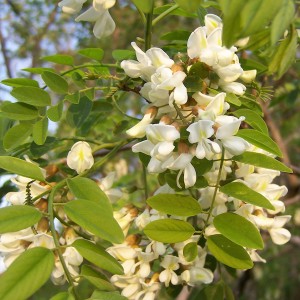Black Locust – January 2015 Wildflower of the Month
 Two trees with similar leaves can be easily distinguished in the winter condition. Black Locust is a medium-sized tree with compound leaves, each leaf divided into 6-20 egg-shaped leaflets. The bark on old trunks is dark and deeply ridged; paired thorns are found on stout twigs. The flowers are fragrant, white and clustered, and fruits are 2-6” long, flat pods.
Two trees with similar leaves can be easily distinguished in the winter condition. Black Locust is a medium-sized tree with compound leaves, each leaf divided into 6-20 egg-shaped leaflets. The bark on old trunks is dark and deeply ridged; paired thorns are found on stout twigs. The flowers are fragrant, white and clustered, and fruits are 2-6” long, flat pods.
The leaves of Honey Locust (Gleditsia triacanthos) are similar, but the bark is relatively smooth with clusters of branched, unpaired thorns along the trunk and twigs. The flowers are small and greenish and the pods are longer and twisted. These long pods, up to 2 feet long, form corkscrew twists as they dry and are seen frequently around the base of the tree.
Black Locust occurs in every county in Virginia and ranges from Pennsylvania to Oklahoma south to Georgia and Alabama. Fast-growing, this tree grows in dry forests, abandoned pastures, clear-cuts and burned areas. Honey Locust is frequent throughout Virginia, growing in old fields, fencerows, and rich moist woods. The range is from Pennsylvania to Tennessee and western Florida, west to southern Minnesota, southeast South Dakota and Texas. Both species start blooming in April and form fruits from July through November.
The heartwood of both species is very resistant to rot and is frequently used for fence posts and railroad ties. Black Locust changes atmospheric nitrogen to usable minerals and can grow on nutrient-poor sites. It can quickly cover a site and is often used for erosion control and soil improvement. The fragrant flowers are very attractive to bees that produce honey.
Honey Locust does not fix atmospheric nitrogen and the stout thorns along the branches and trunk are dangerous and undesirable in a yard or lawn tree. Thornless cultivars often have insect and disease problems.
By Helen Hamilton, past-president of the John Clayton Chapter, VNPS
Photo: Black Locust (Robinia pseudoacacia) taken by Phillip Merritt
